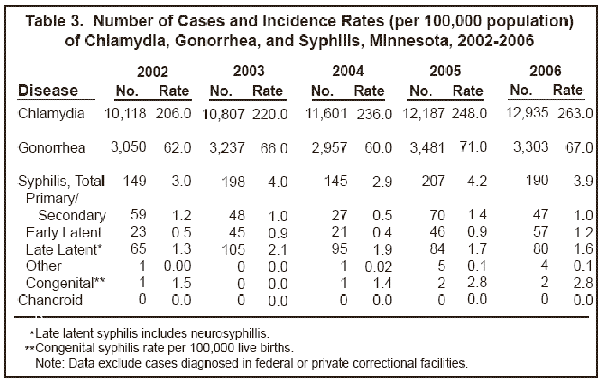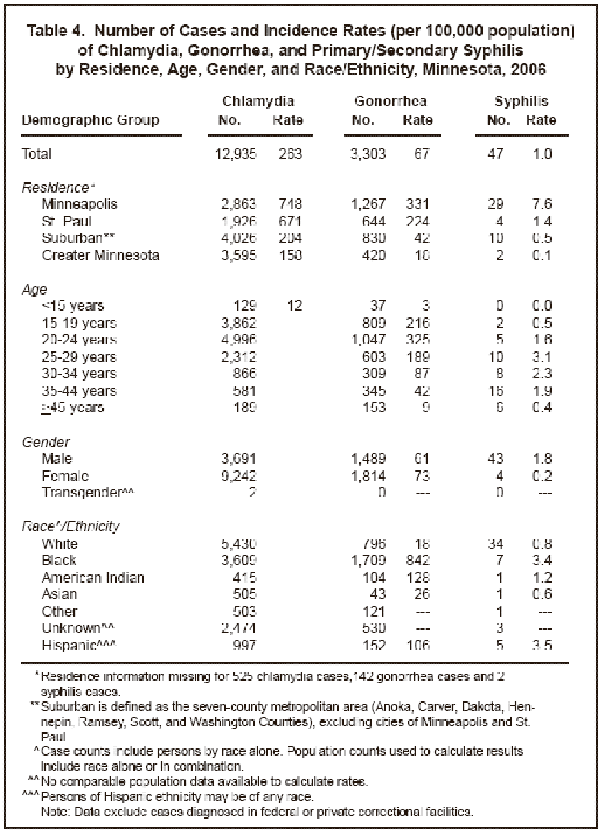Annual Summary of Disease Activity:
Disease Control Newsletter (DCN)
Related Topics
Contact Info
Sexually Transmitted Diseases, 2006
STD Diseases on this page:
Chlamydia
Gonorrhea
Syphilis
Chancroid
Active surveillance for gonorrhea and chlamydia, initiated in 2002, involves cross-checking laboratory-reported cases against cases reported by clinicians. Although both laboratories and clinical facilities are required to report STDs independently of each other, an episode of STD is not considered a case for surveillance purposes until a corresponding case report is submitted by a clinical facility. Case reports contain demographic and clinical information that is not available from laboratory reports. When a laboratory report is received but no corresponding case report is received within 45 days, MDH mails a reminder letter and case report form to the corresponding clinical facility. Cases of syphilis and chancroid are monitored through a mostly passive surveillance system. Herpes simplex virus and human papillomavirus infections are not reportable.
Although overall incidence rates for STDs in Minnesota are lower than those in many other areas of the United States, certain population subgroups in Minnesota have very high STD rates.
Specifically, STDs disproportionately affect adolescents, young adults, and persons of color.
Chlamydia
Chlamydia trachomatis infection is the most commonly reported STD in Minnesota. In 2006, 12,935 chlamydia cases (263 per 100,000) were reported, representing a 5% increase from 2005 (Table 3).
Adolescents and young adults are at highest risk for acquiring chlamydial infection (Table 4). The chlamydia rate is highest among 20 to 24-year-olds (1,549 per 100,000), with the next highest rate among 15 to 19-year-olds (1,032 per 100,000). The incidence of chlamydia among adults 25 to 29 years of age (723 per 100,000) is considerably lower but has increased in recent years. The chlamydia rate among females (372 per 100,000) is more than twice the rate among males (152 per 100,000). This difference is likely due to more frequent screening among women.
The incidence of chlamydia infection is highest in communities of color (Table 4). The rate among blacks (1,778 per 100,000) is over 14 times higher than the rate among whites (126 per 100,000). Although blacks comprise approximately 4% of Minnesota’s population, they account for 28% of reported chlamydia cases. Rates among Asian/Pacific Islanders (300 per 100,000), American Indians (512 per 100,000), and Hispanics (695 per 100,000) are over two to five times higher than the rate among whites.
Chlamydia infections occur throughout the state, with the highest reported rates in Minneapolis (748 per 100,000) and St. Paul (671 per 100,000). In 2006, the greatest increases for chlamydia have been seen in St. Paul and the suburbs with increases of 11% and 9%, respectively.
Gonorrhea
Gonorrhea, caused by Neisseria gonorrhoeae, is the second most commonly reported STD in Minnesota. In 2006, 3,303 cases (67 per 100,000) were reported, representing a decrease of 6% from 2005 (Table 3).
Adolescents and young adults are at greatest risk for gonorrhea (Table 4), with incidence rates of 216 per 100,000 among 15 to 19-year-olds, 325 per 100,000 among 20 to 24-year olds, and 189 per 100,000 among 25 to 29-year-olds. Gonorrhea rates for males (61 per 100,000) and females (73 per 100,000) are comparable. Communities of color are disproportionately affected by gonorrhea, with 52% of cases reported among blacks. The incidence of gonorrhea among blacks (842 per 100,000) is approximately 47 times higher than the rate among whites (18 per 100,000). Rates among American Indians (128 per 100,000) and Hispanics (106 per 100,000) are approximately six to seven times higher than among whites. The rate among Asian/Pacific Islanders (26 per 100,000) is slightly higher than among whites.
Gonorrhea rates are highest in the cities of Minneapolis and St. Paul (Table 4). The incidence in Minneapolis (331 per 100,000) is 1.5 times the rate in St. Paul (224 per 100,000), eight times higher than the rate in the suburban metropolitan area (42 per 100,000), and over 18 times higher than the rate in Greater Minnesota (18 per 100,000).
Quinolone-resistant Neisseria gonorrhoeae
While the overall rate of gonorrhea has stayed relatively constant over the past 3 years, the prevalence of quinolone-resistant N. gonorrhoeae (QRNG) has increased approximately four-fold from 1.4% in 2003 to 5.8% in 2006. Of concern is the high prevalence among men who have sex with men (MSM), which increased sharply from 0% in 2002, to 8.9% in 2003, and to 27% in 2004. Since then the prevalence among MSM has remained stable but elevated (27% in 2006). As a result, fluoroquinolones (e.g., ciprofloxacin) are no longer recommended for treating gonorrhea in men with male sexual partners in Minnesota.
Syphilis
Surveillance data for primary and secondary syphilis are used to monitor morbidity trends because they represent recently acquired infections. Data for early syphilis (which includes primary, secondary, and early latent stages of disease) are used in outbreak investigations because they represent infections acquired within the past 12 months and signify opportunities for disease prevention.
Primary and Secondary Syphilis
The incidence of primary/secondary syphilis in Minnesota is lower than that of chlamydia or gonorrhea (Table 3), but has remained elevated since an outbreak was observed in 2002 among men who have sex with men (MSM). In 2006, 47 cases of primary/secondary syphilis (1.0 per 100,000) were reported compared to 71 (1.4 per 100,000) cases in 2005. Although this represents a 34% decrease, the number of cases has been fluctuating over the past few years.
Early Syphilis
In 2006, the number of early syphilis cases decreased by 12%, with 104 cases occurring in 2006 compared to 118 cases in 2005. The incidence is highest amongst MSM. Of the early syphilis cases in 2006, 90 (88%) occurred among men; 80 (89%) of these men reported having sex with other men; 40% of the MSM diagnosed with early syphilis were co-infected with HIV.
Congenital Syphilis
Two cases of congenital syphilis were reported in Minnesota in 2006 (Table 3).
Chancroid
Chancroid continues to be very rare in Minnesota. No cases were reported in 2006.


- For up to date information see>> Sexually Transmitted Diseases (STDs)
- Full issue>> Annual Summary of Communicable Diseases Reported to the Minnesota Department of Health, 2006